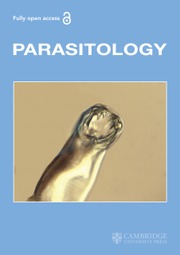Crossref Citations
This article has been cited by the following publications. This list is generated based on data provided by
Crossref.
Khoo, Kay-Hooi
and
Dell, Anne
2001.
The Molecular Immunology of Complex Carbohydrates —2.
Vol. 491,
Issue. ,
p.
185.
Raghavan, Nithya
Miller, Andre N
Gardner, Malcolm
FitzGerald, Peter C
Kerlavage, Anthony R
Johnston, David A
Lewis, Fred A
and
Knight, Matty
2003.
Comparative gene analysis of Biomphalaria glabrata hemocytes pre- and post-exposure to miracidia of Schistosoma mansoni.
Molecular and Biochemical Parasitology,
Vol. 126,
Issue. 2,
p.
181.
Coelho, PMZ
Carvalho, OS
Andrade, ZA
Martins-Sousa, RL
Rosa, FM
Barbosa, L
Pereira, CAJ
Caldeira, RL
Jannotti-Passos, LK
Godard, ALB
Moreira, LA
Oliveira, GC
Franco, GR
Teles, HMS
and
Negrão-Corrêa, D
2004.
Biomphalaria tenagophila/Schistosoma mansoni interaction: premises for a new approach to biological control of schistosomiasis.
Memórias do Instituto Oswaldo Cruz,
Vol. 99,
Issue. suppl 1,
p.
109.
Lockyer, Anne E
Jones, Catherine S
Noble, Leslie R
and
Rollinson, David
2004.
Trematodes and snails: an intimate association.
Canadian Journal of Zoology,
Vol. 82,
Issue. 2,
p.
251.
Martins-Souza, RL
Pereira, CAJ
Martins Filho, OA
Coelho, PMZ
Corrêa Jr, A
and
Negrão-Corrêa, D
2006.
Differential lectin labelling of circulating hemocytes from Biomphalaria glabrata and Biomphalaria tenagophila resistant or susceptible to Schistosoma mansoni infection.
Memórias do Instituto Oswaldo Cruz,
Vol. 101,
Issue. suppl 1,
p.
185.
Castillo, Maria G.
Wu, Xiao-Jun
Dinguirard, Nathalie
Nyame, A. Kwame
Cummings, Richard D.
and
Yoshino, Timothy P.
2007.
SURFACE MEMBRANE PROTEINS OF BIOMPHALARIA GLABRATA EMBRYONIC CELLS BIND FUCOSYL DETERMINANTS ON THE TEGUMENTAL SURFACE OF SCHISTOSOMA MANSONI PRIMARY SPOROCYSTS.
Journal of Parasitology,
Vol. 93,
Issue. 4,
p.
832.
PEREIRA, C. A. J.
MARTINS‐SOUZA, R. L.
CORRÊA JR, A.
COELHO, P. M. Z.
and
NEGRÃO‐CORRÊA, D.
2008.
Participation of cell‐free haemolymph of Biomphalaria tenagophila in the defence mechanism against Schistosoma mansoni sporocysts.
Parasite Immunology,
Vol. 30,
Issue. 11-12,
p.
610.
Mastore, Maristella
and
Brivio, Maurizio F.
2008.
Cuticular surface lipids are responsible for disguise properties of an entomoparasite against host cellular responses.
Developmental & Comparative Immunology,
Vol. 32,
Issue. 9,
p.
1050.
Zahoor, Zahida
Davies, Angela J.
Kirk, Ruth S.
Rollinson, David
and
Walker, Anthony John
2010.
Larval excretory-secretory products from the parasite Schistosoma mansoni modulate HSP70 protein expression in defence cells of its snail host, Biomphalaria glabrata.
Cell Stress and Chaperones,
Vol. 15,
Issue. 5,
p.
639.
Brivio, Maurizio F.
Mastore, Maristella
and
Nappi, Anthony J.
2010.
A pathogenic parasite interferes with phagocytosis of insect immunocompetent cells.
Developmental & Comparative Immunology,
Vol. 34,
Issue. 9,
p.
991.
Mattos, Ana Carolina Alves de
Martins-Souza, Raquel Lopes
Kusel, John Robert
and
Coelho, Paulo Marcos Zech
2011.
Interaction between primary and secondary sporocysts of Schistosoma mansoni and the internal defence system of Biomphalaria resistant and susceptible to the parasite.
Memórias do Instituto Oswaldo Cruz,
Vol. 106,
Issue. 4,
p.
424.
Melo, Cristiane Moutinho Lagos de
de Lima, Amanda Lucena Rosendo
Beltrão, Eduardo Isidoro Carneiro
Cavalcanti, Carmelita C. Bezerra
de Melo-Júnior, Mário Ribeiro
Montenegro, Silvia Maria L.
Coelho, Luana Cassandra B. Barroso
Correia, Maria Tereza dos Santos
and
Carneiro-Leão, Ana Maria dos Anjos
2011.
Potential effects of Cramoll 1,4 lectin on murine Schistosomiasis mansoni.
Acta Tropica,
Vol. 118,
Issue. 2,
p.
152.
Martins-Souza, Raquel Lopes
Pereira, Cintia Aparecida Jesus
Rodrigues, Leonardo
Araújo, Emília Souza
Coelho, Paulo Marcos Zech
Corrêa Jr, Ary
and
Negrão-Corrêa, Deborah
2011.
Participation of N-acetyl-D-glucosamine carbohydrate moieties in the recognition of Schistosoma mansoni sporocysts by haemocytes of Biomphalaria tenagophila.
Memórias do Instituto Oswaldo Cruz,
Vol. 106,
Issue. 7,
p.
884.
Yoshino, Timothy P.
and
Coustau, Christine
2011.
Biomphalaria Snails and Larval Trematodes.
p.
159.
Negrão-Corrêa, D.
Mattos, A. C. A.
Pereira, C. A. J.
Martins-Souza, R. L.
and
Coelho, P. M. Z.
2012.
Interaction ofSchistosoma mansoniSporocysts and Hemocytes ofBiomphalaria.
Journal of Parasitology Research,
Vol. 2012,
Issue. ,
p.
1.
Kawasaki, Minami
Delamare-Deboutteville, Jerome
Dang, Cecile
and
Barnes, Andrew C.
2013.
Hemiuroid trematode sporocysts are undetected by hemocytes of their intermediate host, the ark cockle Anadara trapezia: Potential role of surface carbohydrates in successful parasitism.
Fish & Shellfish Immunology,
Vol. 35,
Issue. 6,
p.
1937.
Rêgo, Moacyr Jesus Barreto de Melo
Vieira-De-Mello, Gabriela Souto
Araújo, Cláudio Witaker
Cavalcanti, Maria do Socorro de Mendonça
and
Beltrão, Eduardo Isidoro Carneiro
2013.
Evaluation of WGA and Concanavalin A (Con A) lectin as biomarkers of hepatosplenic schistosomiasis in human biopsies with no evidence of egg-granuloma system.
Revista do Instituto de Medicina Tropical de São Paulo,
Vol. 55,
Issue. 3,
p.
213.
Abou-El-Naga, Iman F.
El-Nassery, Suzanne M.F.
Allam, Sonia R.
and
Mady, Rasha F.M.
2014.
In vitro interactions between the defense systems of resistant and susceptible Biomphalaria alexandrina and sporocysts of Schistosoma mansoni.
Veterinary Parasitology,
Vol. 205,
Issue. 3-4,
p.
712.
Yoshino, Timothy
Gourbal, Benjamin
and
Théron, André
2016.
Schistosoma.
p.
118.
Pila, Emmanuel A.
Tarrabain, Mahmoud
Kabore, Alethe L.
Hanington, Patrick C.
and
Knight, Matty
2016.
A Novel Toll-Like Receptor (TLR) Influences Compatibility between the Gastropod Biomphalaria glabrata, and the Digenean Trematode Schistosoma mansoni.
PLOS Pathogens,
Vol. 12,
Issue. 3,
p.
e1005513.

